Textile dying in the fashion industry is one of the biggest causes of pollution. This is something that Zimbabwean-born bio-designer and researcher Natsai Audrey Chieza is tackling head on through her work at London-based multidisciplinary design agency, Faber Futures.
Faber Futures, where she is the founder and CEO, works at the intersection of design, technology and nature. The agency equips biotechnology start-ups, multi-sector brands and institutions with the frameworks and tools to adapt to holistic systems for regenerative futures.
The studio recently won an INDEX award for Project Coelicolor, one of its key research projects.
In this project Chieza looked to integrate the inner workings of a pigment-producing bacteria called streptomyces coelicolor with design processes, to try and find a more sustainable way of dying textiles.
The bacteria lives in soil where it helps to decompose organic matter. It also produces an antibiotic called actinorhodin, which ranges in colour from blue, pink and purple, depending on the acidity of its environment.
This method for dyeing textiles is not only chemical-free (as the bacteria is grown directly onto the pigment to generate the pigment and requires no fixing agents) but it also uses up to 500 times less water than commonly used dying processes.
Project Coelicolor: Assemblage 002, 2019; Natsai Audrey Chieza, Faber Futures in collaboration with Professor John Ward, Department of Biochemical Engineering, University College London.Image Credit: Oskar Proctor.
Chieza's interest in bio-design came following an education in architectural design at Edinburgh University and in Material futures at Central Saint Martins.
Besides her leadership at Faber Futures, Chieza is on the founding and curatorial team of Ginkgo Bioworks’ Ginkgo Creative Residency in Boston. The residency offers creatives three months in Boston to work on projects that intersect with different creative disciplines and biology.
Chieza has exhibited at the Cooper Hewitt, Pompidou Centre, Vitra Design Museum, The Bauhaus Dessau Foundation, The Victoria & Albert Museum and Science Gallery Dublin. Her work has been acquired by the Cooper Hewitt and sits in the permanent collection at Forbes Pigment Collection at Harvard Art Museums.
Project Coelicolor: Terroir, 2019; Natsai Audrey Chieza, Faber Futures in collaboration with Professor John Ward, Department of Biochemical Engineering, University College London. Image Credit: Oskar Proctor.
When Design Indaba asked what motivates her, she said: “I am terribly optimistic. It’s why I am doing all this work and asking all these questions. These are pertinent issues that we can collectively address with a mission-driven attitude that integrates a variety of disciplinary expertise with a mindset that anything is possible.”
More on Design Indaba 2020 speakers:
Sunny Dolat is opening up space for a more nuanced discussion on African fashion
Ghana's wunderkind Ibrahim Mahama to share his monumental artworks at Design Indaba 2020










